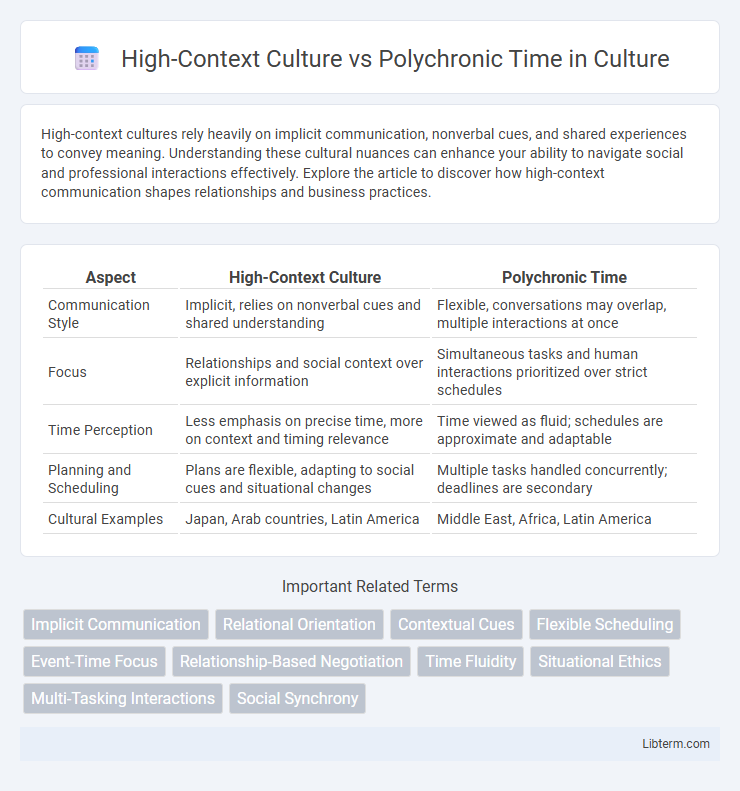High-context cultures rely heavily on implicit communication, nonverbal cues, and shared experiences to convey meaning. Understanding these cultural nuances can enhance your ability to navigate social and professional interactions effectively. Explore the article to discover how high-context communication shapes relationships and business practices.
Table of Comparison
| Aspect | High-Context Culture | Polychronic Time |
|---|---|---|
| Communication Style | Implicit, relies on nonverbal cues and shared understanding | Flexible, conversations may overlap, multiple interactions at once |
| Focus | Relationships and social context over explicit information | Simultaneous tasks and human interactions prioritized over strict schedules |
| Time Perception | Less emphasis on precise time, more on context and timing relevance | Time viewed as fluid; schedules are approximate and adaptable |
| Planning and Scheduling | Plans are flexible, adapting to social cues and situational changes | Multiple tasks handled concurrently; deadlines are secondary |
| Cultural Examples | Japan, Arab countries, Latin America | Middle East, Africa, Latin America |
Understanding High-Context Culture: Key Characteristics
High-context cultures rely heavily on non-verbal cues, implicit communication, and shared experiences to convey meaning, making context crucial for effective interaction. Relationships and social harmony take precedence, with communication often indirect and nuanced to maintain respect and avoid conflict. Time in high-context cultures tends to be flexible and polychronic, emphasizing multitasking and adaptability over strict schedules.
Polychronic Time: Definition and Core Principles
Polychronic time is a cultural concept where multiple tasks and events are handled simultaneously, emphasizing relationships over strict schedules. Core principles include flexibility in time management, prioritizing interpersonal interactions, and valuing social harmony above adherence to deadlines. This approach contrasts with monochronic cultures that view time linearly and prioritize punctuality and sequential task completion.
Communication Styles in High-Context Cultures
High-context cultures emphasize implicit communication, relying on shared experiences, nonverbal cues, and context to convey meaning. Communication is often indirect, with meaning derived from tone, body language, and relationships rather than explicit words. This contrasts with low-context cultures, where clarity and directness are prioritized to avoid misunderstandings in polychronic time settings.
Time Management in Polychronic Societies
Polychronic societies, characterized by high-context cultures, manage time through multitasking and flexible scheduling, prioritizing relationships over strict adherence to clocks. In these societies, time is seen as a fluid resource, allowing simultaneous engagement in multiple activities without rigid deadlines. Understanding this temporal approach is crucial for effective communication and collaboration in cross-cultural environments.
High-Context Culture vs. Polychronic Time: Core Differences
High-context cultures emphasize implicit communication, relying heavily on shared experiences, nonverbal cues, and context to convey meaning. Polychronic time, common in these cultures, involves multitasking and flexible schedules where relationships and interactions take priority over strict adherence to a clock. The core difference lies in high-context cultures valuing deep, contextual understanding, while polychronic time reflects a fluid approach to time management prioritizing interpersonal connections.
Impact on Workplace Dynamics and Collaboration
High-context cultures emphasize implicit communication and relationship-building, which fosters trust and smooth collaboration in workplace dynamics. Polychronic time orientation values multitasking and flexible scheduling, allowing teams to adapt quickly and manage simultaneous projects efficiently. Combining these cultural traits enhances workplace synergy by balancing deep interpersonal connections with dynamic, adaptable workflows.
Navigating Social Interactions: Context vs. Time
High-context cultures rely heavily on nonverbal cues and shared understandings to navigate social interactions, emphasizing relationships over explicit communication. In polychronic time systems, multiple tasks and social engagements occur simultaneously, valuing flexible schedules and the fluidity of conversations. Understanding these dynamics enables effective interaction by balancing nuanced contextual signals with the flexible handling of time commitments.
Challenges in Cross-Cultural Communication
High-context cultures rely heavily on non-verbal cues and implicit messages, while polychronic time orientation involves multitasking and flexible schedules, creating challenges in cross-cultural communication. Misunderstandings often arise when individuals from monochronic time cultures expect punctuality and direct communication, conflicting with polychronic counterparts who prioritize relationships over strict timelines. Overcoming these challenges requires awareness of cultural differences in communication styles and time perception to foster effective intercultural collaboration.
Strategies for Adapting to High-Context, Polychronic Environments
Adapting to high-context, polychronic environments requires developing strong interpersonal communication skills that prioritize reading non-verbal cues and contextual signals. Emphasizing relationship-building and flexibility in scheduling allows for smoother navigation of simultaneous tasks and social interactions common in polychronic cultures. Practicing patience and attentiveness to implicit messages enhances understanding and effectiveness within these culturally complex settings.
Practical Implications for Global Businesses
High-context cultures rely heavily on implicit communication, where relationships and social contexts influence business interactions, requiring global companies to prioritize trust-building and non-verbal cues for successful negotiations. Polychronic time orientations emphasize multitasking and flexible scheduling, urging international businesses to adopt adaptive timelines and accommodate overlapping activities to maintain efficiency and respect local customs. Understanding these dimensions helps global enterprises foster effective collaboration, enhance cross-cultural communication, and improve overall operational performance in diverse markets.
High-Context Culture Infographic

 libterm.com
libterm.com